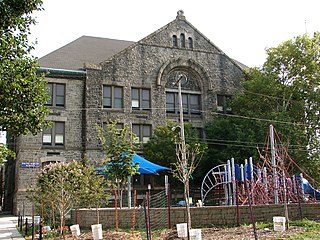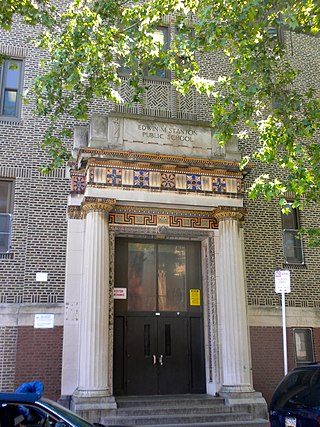
Washington Square West is a neighborhood in Center City, Philadelphia, Pennsylvania, United States. The neighborhood roughly corresponds to the area between 7th and Broad Streets and between Chestnut and South Streets, bordering on the Independence Mall tourist area directly northeast, Market East to the north, Old City and Society Hill to the East, Bella Vista directly south, Hawthorne to the southwest, and mid-town Philadelphia and Rittenhouse Square to the west. In addition to being a desirable residential community, it is considered a hip, trendy neighborhood that offers a diverse array of shops, restaurants, and coffee houses. Washington Square West contains many gay-friendly establishments and hosts annual events celebrating LGBT culture in Philadelphia, including OutFest. The area takes its name from Washington Square, a historic urban park in the northeastern corner of the neighborhood.

The Philadelphia Contributionship for the Insurance of Houses from Loss by Fire is the oldest property insurance company in the United States. It was organized by Benjamin Franklin in 1752 and incorporated in 1768.

Sansom Row is a row of historic houses located at 3402 to 3436 Sansom Street in the University City neighborhood of Philadelphia, Pennsylvania.

The Henry George Birthplace is an historic home which is located in the Washington Square West neighborhood of Philadelphia, Pennsylvania.

William Strickland Row was a set of seven historic rowhouses, four of which survive.

Clinton Street Historic District is a national historic district located in the Washington Square West neighborhood of Philadelphia, Pennsylvania. It includes 71 brick rowhouses built between 1835 and 1850. They are between 3 1/2- and 4-stories and consist of the typical Philadelphia rowhouse plan with front building, piazza, and back building. It was a fashionable residential section in the 19th century and home to such notable figures as architect Addison Hutton (1834–1916), Rt. Rev. William Bacon Stevens (1815-1887), and Agnes Repplier (1855-1950). Located in the district and separately listed is the J. Peter Lesley House at 1008 Clinton Street.

Hockley Row – also known as Evans Row or Victoria House – is a set of four architecturally significant rowhouses, which are located in the Rittenhouse Square West neighborhood of Philadelphia, Pennsylvania.

Ringgold Place is a set of twenty-six historic, American, rowhouses located in the Rittenhouse Square West neighborhood of Philadelphia, Pennsylvania.

The Walnut–Chancellor Historic District is a national historic district that is located in the Rittenhouse Square West neighborhood of Philadelphia, Pennsylvania.

The Rudolph Walton School is an historic, American school building that is located in the Strawberry Mansion neighborhood of Philadelphia, Pennsylvania.

The Bache-Martin Elementary School is a pre-kindergarten to eighth grade school which is located in the Fairmount neighborhood of Philadelphia, Pennsylvania. It is part of the School District of Philadelphia. The school campus comprises two distinct buildings along 22nd Street, both of which were listed on the National Register of Historic Places in 1986.

General Louis Wagner Middle School, formerly General Louis Wagner Junior High School, is a historic middle school located in the West Oak Lane neighborhood of Philadelphia, Pennsylvania. It is a part of the School District of Philadelphia.

Franklin Learning Center, formerly known as William Penn High School for Girls, is a historic high school located in the Spring Garden neighborhood of Philadelphia, Pennsylvania. It is part of the School District of Philadelphia. The building was designed by Henry deCoursey Richards and built in 1908–1909. It was initially an all-girls school and was one of the earliest racially integrated schools in the city. It is a four-story, brick and limestone building in the Classical Revival-style. It features a projecting center section and two-story portico. The school was named for Pennsylvania founder William Penn.

The Mary Channing Wister School, originally the Mary Channing Wister Public School, is an historic, American school building that is located in the Poplar neighborhood of Philadelphia, Pennsylvania.

William W. Bodine High School for International Affairs is an historic high school located in the Northern Liberties neighborhood of Philadelphia, Pennsylvania. It is part of the School District of Philadelphia.

The Thomas Meehan School is an historic, former American school building that is located in the Germantown neighborhood of Philadelphia, Pennsylvania.

Edwin M. Stanton School is an historic K-8 school located in the Southwest Center City neighborhood of Philadelphia, Pennsylvania, within the Christian Street Historic District. It is part of the School District of Philadelphia.

The Nathaniel Irish House is an historic, American home that is located in the Queen Village neighborhood of Philadelphia, Pennsylvania.

Drexel Development Historic District is a national historic district located in the University City neighborhood of Philadelphia, Pennsylvania. It encompasses 96 contributing rowhouses dated to the mid- to late-19th century. A number of the rowhouses were designed by architect Samuel Sloan. The architectural firm G. W. & W. D. Hewitt designed rowhouses for developer Anthony Joseph Drexel on the block bounded by Pine, new 39th, Baltimore, and 40th Streets. They are representative of a number of popular architectural styles including Second Empire, Italianate, and High Victorian.

The Girard Avenue Historic District is a national historic district which is located in the Cabot neighborhood of Philadelphia, Pennsylvania, United States.
























